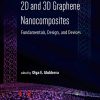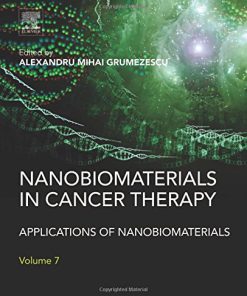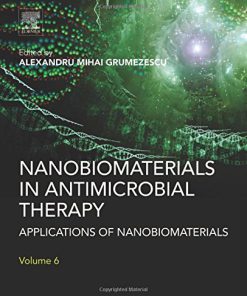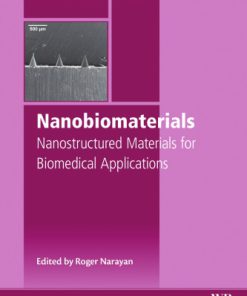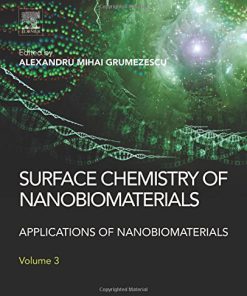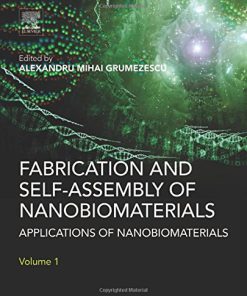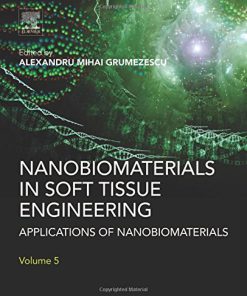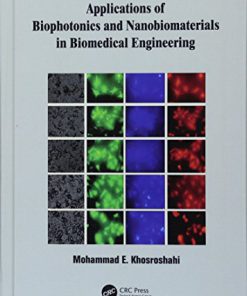Engineering of Nanobiomaterials Applications of Nanobiomaterials Volume 2 1st Edition by Alexandru Mihai Grumezescu ISBN 0323415326 9780323417341
$50.00 Original price was: $50.00.$25.00Current price is: $25.00.
Engineering of Nanobiomaterials Applications of Nanobiomaterials Volume 2 1st Edition by Alexandru Mihai Grumezescu – Ebook PDF Instant Download/Delivery: 0323415326, 9780323417341
Full download Engineering of Nanobiomaterials Applications of Nanobiomaterials Volume 2 1st Edition after payment

Product details:
ISBN 10: 0323415326
ISBN 13: 9780323417341
Author: Alexandru Mihai Grumezescu
Engineering of Nanobiomaterials presents the most recent information regarding the specific modifications of nanomaterials and of their synthesis methods, in order to obtain particular structures for different biomedical purposes. This book enables the results of current research to reach those who wish to use this knowledge in an applied setting.
Engineered nanobiomaterials, designed from organic or inorganic raw materials, offer promising alternatives in many biomedical applications. In this book, eminent researchers from around the world discuss the various applications, including antibacterial therapy, biosensors, cancer therapy, stimuli-responsive drug release, drug delivery, gene therapy and visual prostheses. In each case, advantages, drawbacks and future potential are outlined.
This book will be of interest to students, postdoctoral researchers and professors engaged in the fields of materials science, biotechnology and applied chemistry. It will also be highly valuable to those working in industry, including pharmaceutics and biotechnology companies, medical researchers, biomedical engineers and advanced clinicians.
- An up-to-date and highly structured reference source for students, researchers and practitioners working in biomedical, biotechnological and engineering fields.
- A valuable guide to recent scientific progress, covering major and emerging applications of nanomaterials in the biomedical field.
- Proposes novel opportunities and ideas for developing or improving engineering technologies in nanomedicine/nanobiology.
Engineering of Nanobiomaterials Applications of Nanobiomaterials Volume 2 1st Table of contents:
Chapter 1. Engineering of stimuli-sensitive nanopreparations to overcome physiological barriers and cancer multidrug resistance
Abstract
1.1 Introduction
1.2 Barriers in Drug Delivery
1.3 Stimuli-Sensitive Nanopreparations
1.4 Conclusions
Acknowledgment
References
Chapter 2. Production of complex metal oxide nanopowders using pulsed electron beam in low-pressure gas for biomaterials application
Abstract
2.1 Introduction
2.2 The Description of Installation
2.3 NP Characteristics
2.4 NP Magnetic Properties
2.5 Nano Radiopaque Contrast Substances
2.6 Optically and Thermally Stimulated Luminescence of Nanopowders and Thin Films of Aluminum Oxide
2.7 Conclusions
References
Chapter 3. Bioabsorbable engineered nanobiomaterials for antibacterial therapy
Abstract
3.1 Introduction
3.2 Nanoengineered Natural Herbs as Antibacterial Therapy
3.3 Chitosan
3.4 Conclusions
Acknowledgments
References
Chapter 4. Organic electronic materials for gene delivery
Abstract
4.1 Introduction
4.2 Fullerene-Based Nonviral Vectors for Gene Delivery
4.3 Graphene-Based Nonviral Vectors for Gene Delivery
4.4 Conjugated Polymer-Based Nonviral Vectors for Gene Delivery
4.5 Conclusions
References
Chapter 5. Magnetic modification of cells
Abstract
5.1 Introduction
5.2 Magnetic Modification of Cells
5.3 Conclusions
Acknowledgments
References
Chapter 6. Aptamers as functional bionanomaterials for sensor applications
Abstract
6.1 Introduction
6.2 Discovery of Recognition Elements
6.3 Aptamer Coating Layer Development
6.4 Sensor Signal Transduction Using Aptamers
6.5 Functional Bionanomaterials for Aptasensors
6.6 Future Perspectives
References
Chapter 7. Gene delivery mediated by gemini surfactants: Structure–activity relationships
Abstract
7.1 Introduction
7.2 Gemini Surfactants: Synthesis and Physicochemical Behavior
7.3 Physicochemical Properties
7.4 Surface Activity and Micellization
7.5 Self-Assembly
7.6 Structural Modulation Featuring Biological Properties
7.7 Conclusions
Acknowledgments
References
Chapter 8. Nanobiomaterials for bionic eye: Vision of the future
Abstract
8.1 Introduction
8.2 Learning from the Nature
8.3 Bionic Eye
8.4 Challenges in the Design and Fabrication of a Bionic Eye
8.5 Nanobiomaterial Point of View
8.6 Conclusions
References
Chapter 9. Bioactive-functionalized interpenetrating network hydrogel (BIOF-IPN)
Abstract
9.1 Introduction
9.2 Generation of Free Radicals in Living Systems
9.3 Intelligent Functional Biomaterials
9.4 Practical in vitro Applications of the BIOF-IPN in Dentistry
9.5 Conclusions and Future Directions
References
Chapter 10. Engineered nanomaterials for biomedicine: Advancements and hazards
Abstract
10.1 Introduction
10.2 Nano–Bio Interfaces: Interaction
10.3 Biomimic
10.4 Nanomaterials and Drug Delivery
10.5 Therapeutic Applications of Nanomaterials
10.6 Nanomaterials and Scaffold Reinforcements
10.7 Nanobiosensors
10.8 Nanobiomaterial: Immunogenicity
10.9 Nanotoxicology
10.10 Conclusions
References
Chapter 11. Mechanism of nanomachining semiconductor and ceramic blades for surgical applications
Abstract
11.1 Introduction
11.2 Study of the Mechanism of Ceramic Knife Fabrication Using Discrete Element Method
11.3 Study of the Mechanism of Silicon Knife Fabrication Using Molecular Dynamics
11.4 Conclusions
References
Further Reading
Chapter 12. Design and implementation of an electrospinning system
Abstract
Nomenclature
12.1 Introduction
12.2 Mathematical Model
12.3 Experimental Observations
12.4 Computer Simulations
12.5 Conclusions
References
Appendix
Chapter 13. Engineered nanoparticles as a precise delivery system in cancer therapeutics
Abstract
13.1 Introduction
13.2 Nanoparticles in Cancer Therapeutics
13.3 Engineered Nanoparticles in Cancer Therapeutics
13.4 Conclusions
References
Chapter 14. Inorganic nanoflotillas as engineered particles for drug and gene delivery
Abstract
14.1 Introduction
14.2 What Are the Essential Properties of Nanoparticles for Therapeutic Purposes?
14.3 Physiological Barriers to Be Circumvented by Inorganic Nanoparticles for Effective Drug/Gene and Gene Delivery
14.4 Inorganic Nanoflotillas as Propellers for Drug/Gene Delivery via Surface Functionalization
14.5 Conclusions
References
Chapter 15. Chemical and green routes for the synthesis of multifunctional pure and substituted nanohydroxyapatite for biomedical applications
Abstract
15.1 Introduction
15.2 Materials
15.3 Characterization Techniques
15.4 Chemical Synthesis of Pure and Substituted n-HA Particles
15.5 Green Route Synthesis of n-HA
15.6 Conclusions
People also search for Engineering of Nanobiomaterials Applications of Nanobiomaterials Volume 2 1st:
engineering of nanobiomaterials. applications
nanomaterials engineering
engineering nanotechnology
engineered nanoparticles examples
engineered nanoparticles
Tags:
Alexandru Mihai Grumezescu,Engineering,Nanobiomaterials Applications,Nanobiomaterials
You may also like…
Science (General)
Engineering - Civil & Structural Engineering


